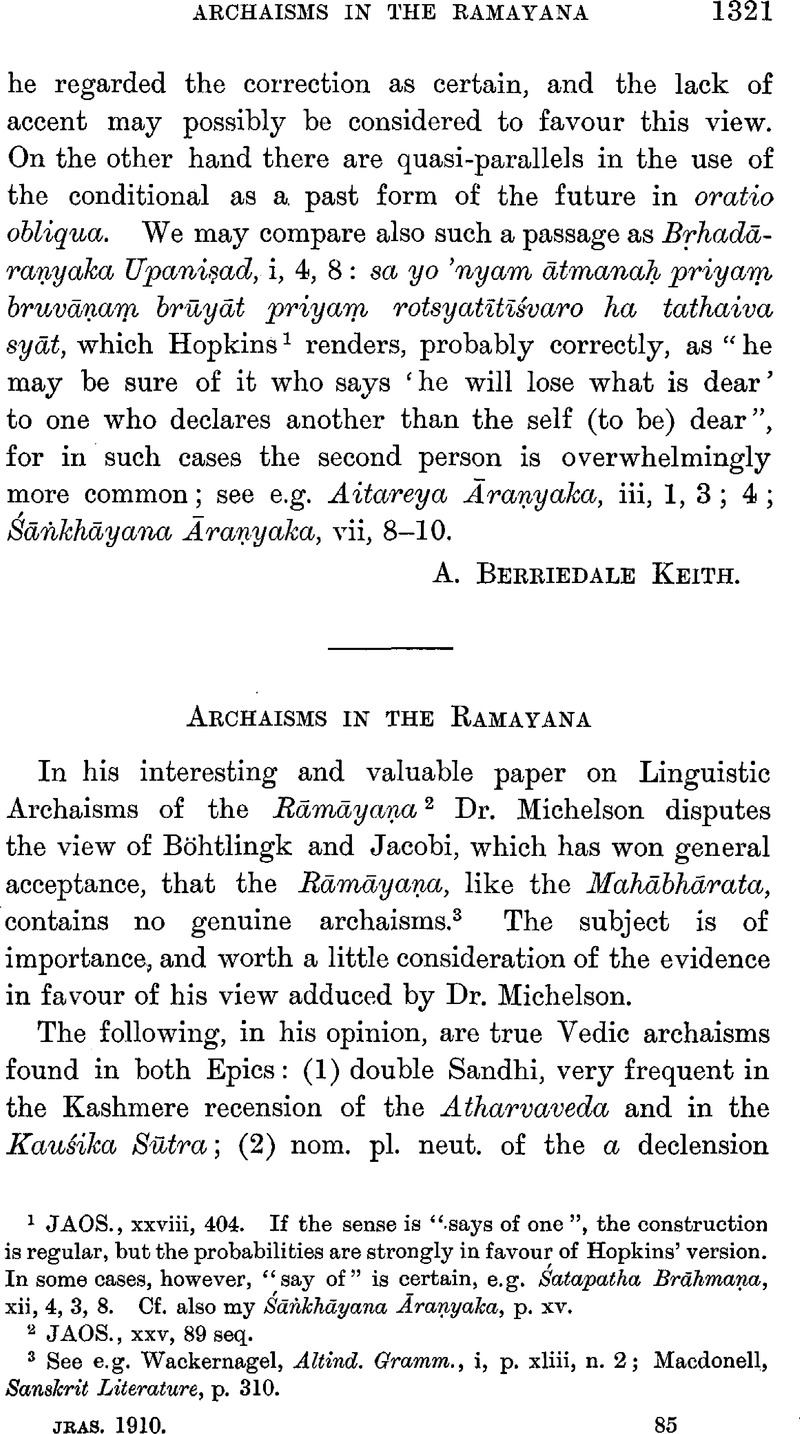No CrossRef data available.
Article contents
Archaisms in the Rāmāyaṇa
Published online by Cambridge University Press: 15 March 2011
Abstract

- Type
- Miscellaneous Communications
- Information
- Copyright
- Copyright © The Royal Asiatic Society 1910
References
page 1321 note 1 JAOS., xxviii, 404. If the sense is “.says of one”, the construction is regular, but the probabilities are strongly in favour of Hopkins' version. In some cases, however, “say of” is certain, e.g. Śatapatha Brāhmana, xii, 4, 3, 8. Cf. also my Śāṅkhāyana Āraṇyaka, p. xv.
page 1321 note 2 JAOS., xxv, 89 seq.
page 1321 note 3 See e.g. Wackernagel, , Altind. Gramm., i, p. xliii, n. 2Google Scholar; Macdonell, , Sanskrit Literature, p. 310Google Scholar.
page 1322 note 1 Cf. Wackernagel, op. cit., pp. 315 seq.
page 1322 note 2 JAOS., xxv, 100.
page 1322 note 3 Studies about the Kathāsaritsāgara, p. 90.
page 1323 note 1 Cf. Wackernagel, p. 317. It is quite probable that in the Ṛgveda such cases are real contractions (Oldenberg, ZDMG., lxi, 830 seq.), but that does not affect the cause of their use in the Epic.
page 1323 note 2 JAOS., xxv, 142. On the other hand, s and sy are constantly interchanged in MSS.; cf. my Aitareya Āraṇyaka, pp. 245, 246; JAOS., xxvii, 430.
page 1323 note 3 xiii, 102, 55, and vii, 201, 77, cited in JAOS., xxv, 104, and see Hopkins, , JAOS., xvii, 25, noteGoogle Scholar.
page 1323 note 4 A similar “archaism” is the Mbh. Indrāviṣṇū, a mere repeated phrase.
page 1324 note 1 For a possible meaning of the grammarian's rule as to the use of °āt, which is questioned by Whitney, , Sanskrit Grammar, p. 214Google Scholar, see my Aitareya Āraṇyaka, p. 275.
page 1324 note 2 JAOS., xxv, 125. I am quite at a loss to understand how this of all usages is treated as an archaism. It is a neoterism of the most pronounced description.
page 1325 note 1 Read °bhaviṣṇavo with Böhtlingk.
page 1325 note 2 JAOS., xxv, 123, 124.
page 1325 note 3 e.g. optative for indicative, and vice versa. Cf. Hopkins, , Great Epic of India, p. 264Google Scholar.
page 1325 note 4 For this use of the present cf. Goodwin, , Greek Moods and Tenses, p. 11Google Scholar; Whitney, , Sanskrit Grammar, p. 278Google Scholar; Speyer, , Vedische und Sanskrit Syntax, p. 51Google Scholar. There are many instructive variants in parallel passages in Vedie texts, cf. e.g. Atharvaveda, viii, 21, with Śāṅkhāyana Āraṇyaka, xii, 12, and see Bloomfield, , JAOS., xxix, 294, 295Google Scholar.
page 1325 note 5 The ordinary unaugmented tenses used in a past sense are not specially Vedic. They occur throughout all but very correct Sanskrit, and are found in Pāli and Prākrit (Pischel, , Prākrit Grammar, p. 360)Google Scholar.
page 1326 note 1 JAOS., xxv, 123. Cf. also bhaveḥ cited in Great Epic of India, p. 473.


